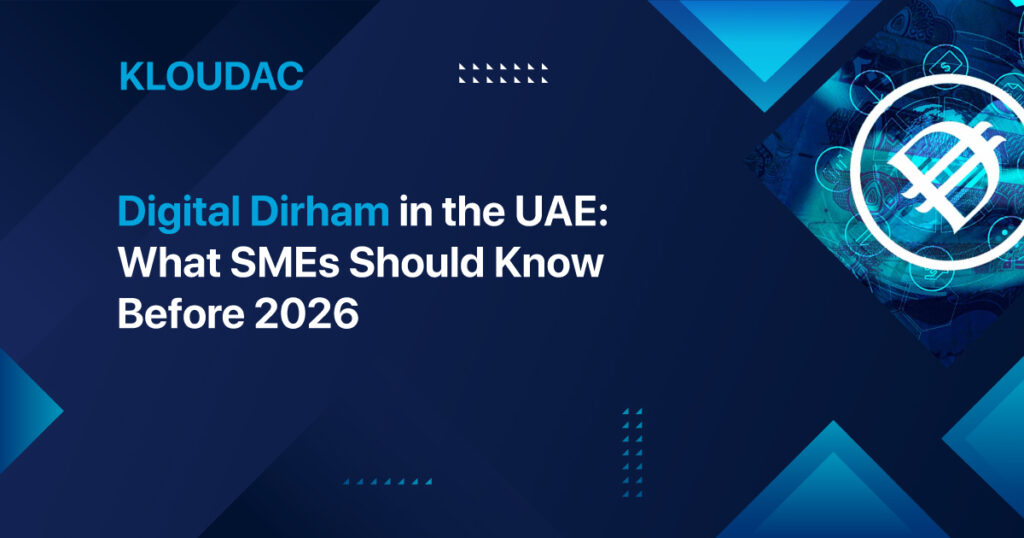The UAE is taking a bold leap into the future of finance with the rollout of its Digital Dirham, a central bank digital currency (CBDC) that aims to revolutionize how money moves across the country and beyond. Backed by the Central Bank of the UAE and powered by blockchain, the Digital Dirham will soon become legal tender, introducing faster, more secure, and programmable transactions across sectors.
But for small and medium enterprises (SMEs), this isn’t just a tech update; it’s a strategic shift. From instant cross-border payments to real-time treasury visibility, the Digital Dirham brings a wave of opportunities. As the official rollout moves closer to 2026, understanding what it means and how to prepare has never been more important.
What Is the Digital Dirham?
The Digital Dirham is the UAE’s version of a central bank digital currency. Unlike cryptocurrencies such as Bitcoin, the government backs this currency and designs it to work alongside physical cash and existing digital banking systems. Its programmability and real-time transaction capabilities set it apart, enabling efficient processes such as automated rent payments and faster supply chain settlements.
Timeline: How the Digital Dirham Is Being Deployed
The UAE’s journey with CBDCs began years ago through key pilot projects:
- Project Aber (2019–2020): A joint initiative with Saudi Arabia to test cross-border payments using digital currencies.
- mBridge (2021–2024): A global test network with China, Thailand, and the Bank for International Settlements (BIS), processing over $22 million in instant transfers.
- UAE–India corridor (2024): Launched to facilitate real-time remittance and trade payments.
The national rollout is structured in phases:
| Year | Milestone |
| Mar 2023 | CBDC strategy launched; R3 and G42 Cloud selected as tech partners |
| Early 2024 | Domestic pilot launched; CBDC declared legal tender |
| Late 2025 | Retail adoption begins across the banking sector |
| 2026 | Mandatory integration across the UAE’s licensed financial institutions |
Key Benefits for UAE Businesses
The Digital Dirham is designed to serve more than just consumers. It unlocks a host of benefits specifically for SMEs:
1. Real-Time Payments
No more waiting days for bank settlements. With CBDC infrastructure, payments clear instantly even across borders, improving liquidity and cash flow.
2. Lower Transaction Costs
The system reduces intermediaries and makes settlement more direct, lowering processing fees for both domestic and international payments.
3. Smart Contract Capabilities
Imagine a system that triggers payments automatically when shipments arrive or contract milestones are met. This is possible with the programmable nature of the Digital Dirham.
4. Stronger Compliance & Auditing
With built-in KYC (Know Your Customer) and AML (Anti-Money Laundering) layers, businesses will benefit from cleaner records, easier VAT reporting, and reduced fraud risks.
What SMEs Should Do to Get Ready
If you’re a business owner in the UAE, here’s how to prepare for the Digital Dirham before 2026:
- Talk to your bank or payment provider.
Ask whether they support CBDC wallets and how they plan to integrate with government systems. - Audit your internal tech systems.
Ensure your accounting, ERP, and e-commerce tools are compatible with blockchain-powered transactions. - Upgrade your payment acceptance.
Enable QR-code or NFC-based systems that will accept CBDC payments once launched for retail. - Train your team.
Employees in finance, sales, and customer service should understand how Digital Dirham payments work, including refund handling and compliance processes. - Explore new business models.
With programmable payments, consider models like dynamic pricing, escrow-linked services, or tokenized loyalty schemes.
Why Acting Early Gives You an Edge
By preparing now, SMEs can gain a first-mover advantage in a system that will soon become a legal and operational necessity. Businesses that adapt early will be able to reduce operational friction, appeal to tech-savvy customers, and attract forward-looking investors. The Digital Dirham will change how businesses sign contracts, settle supply-chain payments, and manage their books.
The Digital Dirham is not some futuristic idea; it’s here, it’s official, and it’s moving fast. For SMEs in the UAE, this is a rare chance to ride the wave of digital finance transformation. By taking steps now, you’ll be ready not just to survive, but to lead in a more agile and transparent financial system.
